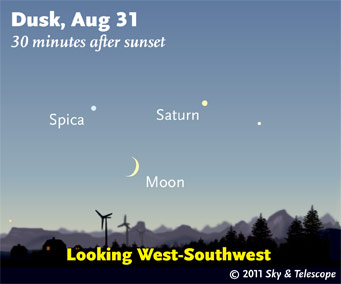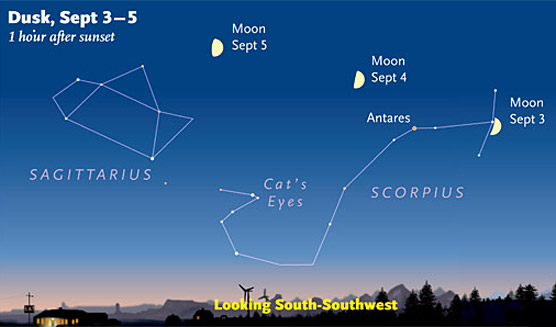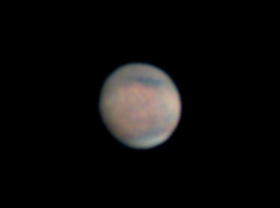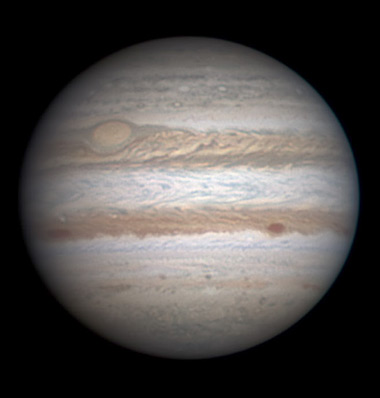
Supernova 2011fe brightens from nothing in these early images taken with the 48-inch (1.2-m) Schmidt telescope at Palomar Observatory on the evenings of August 22, 23, and 24, 2011. Click here for larger views. As of August 29th, the supernova had become brighter than the galaxy's nucleus in amateur telescopes.
Supernova in M101. A supernova for backyard telescopes continues brightening in M101, the Pinwheel Galaxy off the Big Dipper's handle. Supernova 2011fe was discovered at magnitude 17.2 on August 24th, reached 13.8 on the 25th, and 12.5 on the 27th. On the American evening of the 29th (August 30.1 UT) I estimated it at magnitude 11.5 using a 12.5-inch scope at 75× and an AAVSO comparison-star chart. It was more readily visible than the galaxy itself in my moderately light-polluted suburban sky. Then on the evening of the 30th Tony Flanders put it at 11.2. On the evening of the 31st it was about 10.8. No sign of stopping yet!
The supernova should top out at about magnitude 10.6 if it's a standard Type Ia, as seems to be the case. See our article, Supernova Erupts in Pinwheel Galaxy. Plan to observe soon after dark while the Dipper's handle is still high.
Friday, Aug. 26
Saturday, Aug. 27
Sunday, Aug. 28
Monday, Aug. 29
Tuesday, Aug. 30

A temporary "Southwest Triangle." The visibility of objects in bright twilight is exaggerated here. This arrangement is exact for an observer in the middle of North America.
Sky & Telescope diagram
Wednesday, Aug. 31
Thursday, Sept. 1
Friday, Sept. 2

The waxing Moon marches above Scorpius and Sagittarius as they decline at dusk. For clarity, the Moon is shown three times its actual apparent size.
Sky & Telescope diagram
Saturday, Sept. 3
Want to become a better amateur astronomer? Learn your way around the constellations. They're the key to locating everything fainter and deeper to hunt with binoculars or a telescope.
For an easy-to-use constellation guide covering the whole evening sky, use the big monthly map in the center of each issue of Sky & Telescope, the essential magazine of astronomy. Or download our free Getting Started in Astronomy booklet (which only has bimonthly maps).
Sky Atlas 2000.0 (the color Deluxe Edition is shown here) plots 81,312 stars to magnitude 8.5. That includes most of the stars that you can see in a good finderscope, and typically one or two stars that will fall within a 50× telescope's field of view wherever you point. About 2,700 deep-sky objects to hunt are plotted among the stars.
Alan MacRobert
Once you get a telescope, to put it to good use you must have a detailed, large-scale sky atlas (set of charts). The standards are the Pocket Sky Atlas, which shows stars to magnitude 7.6; the larger Sky Atlas 2000.0 (stars to magnitude 8.5); and the even larger and deeper Uranometria 2000.0 (stars to magnitude 9.75). And read how to use sky charts effectively.
You'll also want a good deep-sky guidebook, such as Sky Atlas 2000.0 Companion by Strong and Sinnott, or the more detailed and descriptive Night Sky Observer's Guide by Kepple and Sanner, or the classic if dated Burnham's Celestial Handbook.
Can a computerized telescope take their place? I don't think so — not for beginners, anyway, and especially not on mounts that are less than top-quality mechanically. As Terence Dickinson and Alan Dyer say in their Backyard Astronomer's Guide, "A full appreciation of the universe cannot come without developing the skills to find things in the sky and understanding how the sky works. This knowledge comes only by spending time under the stars with star maps in hand."
This Week's Planet Roundup

If you have any doubt that stacked-video imaging can do black magic on planets, compared to what you can see by eye in the same telescope, look at this. Mars was a mere 4.5 arcseconds wide on August 13th when John Boudreau of Saugus, Massachusetts, took this image with an 11-inch scope. Visually, Mars at that size is a tiny, featureless fuzzblob.
Click for animation of two images showing 7 minutes of the planet's rotation. This makes it easy to see what features here are real rather than noise. Hint: Most of them are.
Boudreau used a C-11 telescope at f/38 with a PGR Flea 3 camera and Astrodon RGB color filters. He rated the seeing only 6 or 7 on a scale of 10. And the planet was only 32° high. (South is up.)
John Boudreau
Mercury is emerging into view low in the dawn, brightening day by day. Look for it low in the east about an hour before sunrise; the later in the week the better. It's far down below Mars, Castor, and Pollux.
Venus is hidden in the glare of the Sun.
Mars (magnitude +1.4, crossing Gemini) rises around 2 a.m. daylight-saving time. By the beginning of dawn it's in good view well up in the east, to the right of Castor and Pollux. In a telescope, Mars is just a tiny blob only 4.7 arcseconds in diameter.
Jupiter (magnitude –2.6, in southern Aries) rises in the east-northeast around 10 p.m. daylight saving time. Look above it for the little star pattern of Aries and (once Jupiter is well up) closer below it for the head of Cetus, rather dim. Jupiter shines highest in the south just before dawn, making this the best time to examine it with a telescope. It's 44 arcseconds wide.
Saturn (magnitude +0.9, in Virgo) sinks down to the western horizon during twilight. Look for it far below high, bright Arcturus. Binoculars help. Left of Saturn by 10° twinkles Spica.

Another amazing stacked-video shot, taken by Christopher Go on August 29th. Jupiter's dark-rimmed Great Red Spot is upper left of center. Lower right of center, note the very dark red oval in the North Equatorial Belt. South is up.
Uranus (magnitude 5.8, in western Pisces) and Neptune (magnitude 7.8, in western Aquarius) are well up in the south and southeast before midnight. Use our printable finder chart for both.
Pluto (magnitude 14.0, in northern Sagittarius) is still in the south-southwest right after dark; don't delay. A big finder chart for it is in the July Sky & Telescope, page 64.
All descriptions that relate to your horizon — including the words up, down, right, and left — are written for the world's mid-northern latitudes. Descriptions that also depend on longitude (mainly Moon positions) are for North America. Eastern Daylight Time (EDT) equals Universal Time (also known as UT, UTC, or GMT) minus 4 hours.
To be sure to get the current Sky at a Glance, bookmark this URL:
http://SkyandTelescope.com/observing/ataglance?1=1
If pictures fail to load, refresh the page. If they still fail to load, change the 1 at the end of the URL to any other character and try again.
 0
0
Comments
You must be logged in to post a comment.